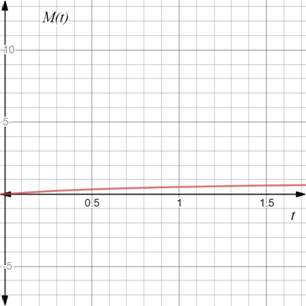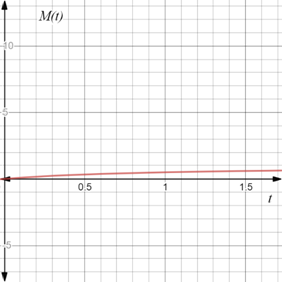
To calculate: The first and second derivative of the function M(t)=t1+t for t>0 also sketch the graph of the function.
Answer to Problem 22E
The value of first derivative of the function is M'(t)=1(1+t)2 and second derivative is M''(t)=−2(1+t)3 . The graph of the function M(t)=t1+t for t>0 is,

Explanation of Solution
Given information:
The function M(t)=t1+t .
Formula used:
Let a function g be continuous on closed interval [c,d] and differentiable on open interval (c,d) ,
If first derivative of the function is greater than zero that is g'(x)>0 for every x in (c,d) , then the function g is increasing on interval [c,d] .
If first derivative of the function is less than zero that is g'(x)<0 for every x in (c,d) , then the function g is decreasing on interval [c,d] .
If second derivative of the function is greater than zero that is g''(x)>0 for every x in (c,d) , then the function g is concave up on interval [c,d] .
If second derivative of the function is less than zero that is g''(x)<0 for every x in (c,d) , then the function g is concave down on interval [c,d] .
The point where the graph changes it nature is known as the point of inflection.
Quotient rule of differentiation, ddx(fg)=gf'−fg'g2 .
Calculation:
Consider the provided function M(t)=t1+t .
Evaluate the first derivative of the function, apply the quotient rule of differentiation, ddx(fg)=gf'−fg'g2 .
ddtM(t)=ddt(t1+t)=(1+t)⋅1−t(0+1)(1+t)2=1(1+t)2
Evaluate the second derivative of the function, differentiate the first derivative again with respect to x .
d2dt2M(t)=ddt(1(1+t)2)
Apply the quotient rule of differentiation, ddx(fg)=gf'−fg'g2 .
d2dt2M(t)=ddt(1(1+t)2)=(1+t)1⋅0−1⋅2(1+t)(1+t)4=−2(1+t)(1+t)3=−2(1+t)3
Recall if first derivative of the function is greater than zero that is g'(x)>0 for every x in (c,d) , then the function g is increasing on interval [c,d] .
If first derivative of the function is less than zero that is g'(x)<0 for every x in (c,d) , then the function g is decreasing on interval [c,d] .
If second derivative of the function is greater than zero that is g''(x)>0 for every x in (c,d) , then the function g is concave up on interval [c,d] .
If second derivative of the function is less than zero that is g''(x)<0 for every x in (c,d) , then the function g is concave down on interval [c,d] .
To sketch the graph of the function M(t)=t1+t follow the steps below,
Observe that first derivative of the function M'(t)=1(1+t)2 is positive for t>0 , so M(t)=t1+t is an increasing function.
Next observe that second derivative of the function M''(t)=−2(1+t)3 is negative for t>0 , so M(t)=t1+t is concave down always.
Therefore, the graph of the function M(t)=t1+t for t>0 is provided below,

Thus, the value of first derivative of the function is M'(t)=1(1+t)2 and second derivative is M''(t)=−2(1+t)3 .
Want to see more full solutions like this?
Chapter 2 Solutions
Modeling the Dynamics of Life: Calculus and Probability for Life Scientists
- Please help me organize the proof of the following theorem:arrow_forwardHow come that I marked ?arrow_forwardIn Exercises 1-14, state whether each statement is true or false. If false, give a reason. 1. The set of stores located in the state of Wyoming is a well- defined set. 2. The set of the three best songs is a well-defined set. 3. maple = {oak, elm, maple, sycamore} 4{} cơ 5. {3, 6, 9, 12,...} and {2, 4, 6, 8, ...} are disjoint sets. 6. {Mercury, Venus, Earth, Mars} is an example of a set in roster form. 7. {candle, picture, lamp} = {picture, chair, lamp } 8. {apple, orange, banana, pear} is equivalent to {tomato, corn, spinach, radish}.arrow_forward
- Exercises Evaluate the following limits. 1. lim cot x/ln x +01x 2. lim x² In x +014 3. lim x* x0+ 4. lim (cos√√x)1/x +014 5. lim x2/(1-cos x) x10 6. lim e*/* 818 7. lim (secx - tan x) x-x/2- 8. lim [1+(3/x)]* x→∞0arrow_forwardIn Exercises 1 through 3, let xo = O and calculate P7(x) and R7(x). 1. f(x)=sin x, x in R. 2. f(x) = cos x, x in R. 3. f(x) = In(1+x), x≥0. 4. In Exercises 1, 2, and 3, for |x| 1, calculate a value of n such that P(x) approximates f(x) to within 10-6. 5. Let (an)neN be a sequence of positive real numbers such that L = lim (an+1/an) exists in R. If L < 1, show that an → 0. [Hint: Let 1111 Larrow_forwardiation 7. Let f be continuous on [a, b] and differentiable on (a, b). If lim f'(x) xia exists in R, show that f is differentiable at a and f'(a) = lim f'(x). A similar result holds for b. x-a 8. In reference to Corollary 5.4, give an example of a uniformly continuous function on [0, 1] that is differentiable on (0, 1] but whose derivative is not bounded there. 9. Recall that a fixed point of a function f is a point c such that f(c) = c. (a) Show that if f is differentiable on R and f'(x)| x if x 1 and hence In(1+x) 0. 12. For 0 л/2. (Thus, as x л/2 from the left, cos x is never large enough for x+cosx to be greater than л/2 and cot x is never small enough for x + cot x to be less than x/2.)arrow_forward
- 1. Show that f(x) = x3 is not uniformly continuous on R. 2. Show that f(x) = 1/(x-2) is not uniformly continuous on (2,00). 3. Show that f(x)=sin(1/x) is not uniformly continuous on (0,л/2]. 4. Show that f(x) = mx + b is uniformly continuous on R. 5. Show that f(x) = 1/x2 is uniformly continuous on [1, 00), but not on (0, 1]. 6. Show that if f is uniformly continuous on [a, b] and uniformly continuous on D (where D is either [b, c] or [b, 00)), then f is uniformly continuous on [a, b]U D. 7. Show that f(x)=√x is uniformly continuous on [1, 00). Use Exercise 6 to conclude that f is uniformly continuous on [0, ∞). 8. Show that if D is bounded and f is uniformly continuous on D, then fis bounded on D. 9. Let f and g be uniformly continuous on D. Show that f+g is uniformly continuous on D. Show, by example, that fg need not be uniformly con- tinuous on D. 10. Complete the proof of Theorem 4.7. 11. Give an example of a continuous function on Q that cannot be continuously extended to R. 12.…arrow_forwardcan I see the steps for how you got the same answers already provided for μ1->μ4. this is a homework that provide you answers for question after attempting it three triesarrow_forward1. Prove that for each n in N, 1+2++ n = n(n+1)/2. 2. Prove that for each n in N, 13 +23+ 3. Prove that for each n in N, 1+3+5+1 4. Prove that for each n ≥ 4,2" -1, then (1+x)" ≥1+nx for each n in N. 11. Prove DeMoivre's Theorem: fort a real number, (cost+i sint)" = cos nt + i sinnt for each n in N, where i = √√-1.arrow_forward
- Pls help ASAParrow_forward2. Sam and Deb have a weekly net income of $1500. They have a pet dog. Their monthly expenses, not related to housing, are $2875. They have savings of $32 000. They are considering two housing options: Option 1: Renting a 2-bedroom condo for $1650 a month, plus utilities averaging $210 a month Option 2: Buying a 2-bedroom condo for a down payment of $24 500, bi-weekly mortgage payments of $1100, and a monthly condo fee of $475 a) Determine the monthly cost of each housing option. Factoring in other expenses not related to housing, which one can Sam and Deb afford? b) Suppose their dog falls ill and they have to pay $85 every week to cover veterinarian and medical expenses. Calculate the additional monthly expenses. How much money would be available for savings if they choose housing option 2?arrow_forwardI bought sparrows at 3 for a penny, turtle doves at 2 for a penny, anddoves at 2 pence each. If I spent 30 pence buying 30 birds and boughtat least one of each kind of bird, how many birds of each kind did I buy?(This is a problem from Fibonacci’s Liber Abaci, 1202.)arrow_forward
 Algebra and Trigonometry (MindTap Course List)AlgebraISBN:9781305071742Author:James Stewart, Lothar Redlin, Saleem WatsonPublisher:Cengage LearningAlgebra & Trigonometry with Analytic GeometryAlgebraISBN:9781133382119Author:SwokowskiPublisher:Cengage
Algebra and Trigonometry (MindTap Course List)AlgebraISBN:9781305071742Author:James Stewart, Lothar Redlin, Saleem WatsonPublisher:Cengage LearningAlgebra & Trigonometry with Analytic GeometryAlgebraISBN:9781133382119Author:SwokowskiPublisher:Cengage
 College AlgebraAlgebraISBN:9781305115545Author:James Stewart, Lothar Redlin, Saleem WatsonPublisher:Cengage Learning
College AlgebraAlgebraISBN:9781305115545Author:James Stewart, Lothar Redlin, Saleem WatsonPublisher:Cengage Learning Algebra: Structure And Method, Book 1AlgebraISBN:9780395977224Author:Richard G. Brown, Mary P. Dolciani, Robert H. Sorgenfrey, William L. ColePublisher:McDougal Littell
Algebra: Structure And Method, Book 1AlgebraISBN:9780395977224Author:Richard G. Brown, Mary P. Dolciani, Robert H. Sorgenfrey, William L. ColePublisher:McDougal Littell





